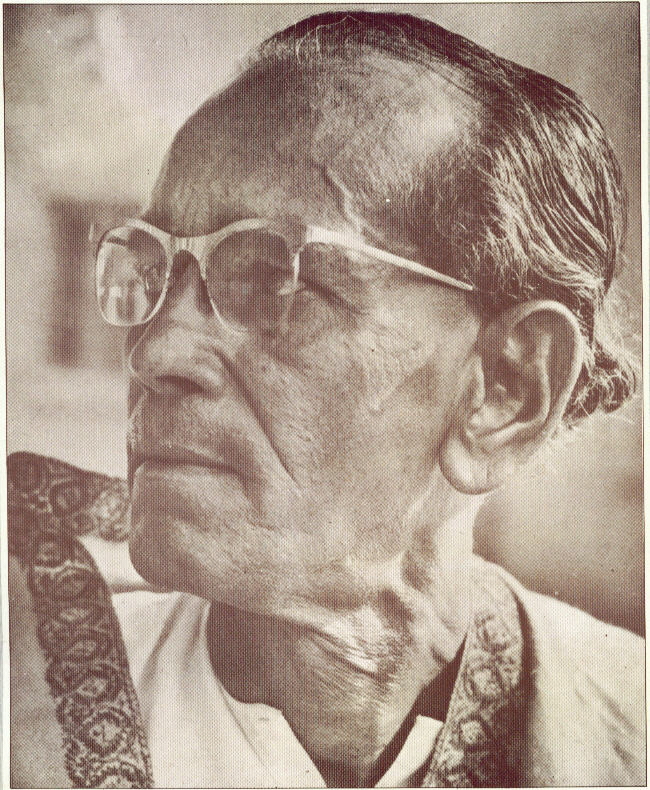 Tarasankar
Banerjee, one of the greatest Indian literary intellectuals of his country,
served not only as a turning point for future Indian writers to come, but also
as an individual who not only studied history, but also made history too.
Tarasankar
Banerjee, one of the greatest Indian literary intellectuals of his country,
served not only as a turning point for future Indian writers to come, but also
as an individual who not only studied history, but also made history too. Tarasankar: A Look into the Man
 Tarasankar
Banerjee, one of the greatest Indian literary intellectuals of his country,
served not only as a turning point for future Indian writers to come, but also
as an individual who not only studied history, but also made history too.
Tarasankar
Banerjee, one of the greatest Indian literary intellectuals of his country,
served not only as a turning point for future Indian writers to come, but also
as an individual who not only studied history, but also made history too.
" With Manik and Bibhutibhushan, Tarashankar
Bandyopadhyay (taaraasha.nkar bandyopaadhyaaY) completes the famous triad
of the "Banerjee"s (or Bandyopadhyaays) of Bengali literature.
Tarasankar was
born in a zamindar family on July 23, 1898 at a village called Labhpur in the
district Birbhum of West Bengal. After high school in the village, he went to
Calcutta for higher studies. However, because of his associations with the
freedom-fighters, the British authority had him interned in his ancestral house
on two occasions. Later on, Tarasankar became an active social worker,
tirelessly working often for months on end when epidemics ravaged this backward
region. Thus he had the opportunity to observe very closely the people in his
locality, a majority of whom belonged to the so called lower-strata of the
society --- tribals, bagdi, bauri, dom, sadgop, etc. And he did so not
from a social distance; Tarasankar's love for this region continued to shine
through all his writings even when he had settled in Kolkata, away from his
beloved Birbhum. He successfully introduced the regional dialect into his
writings. Now Tarasankar's distinctiveness lie in the following: He talked about
a rural world- a rural society which was never so largely and so intuitively and
so closely ever figured in the writings of Bengali and Indian literature. Prior
to him, there were rural Bengal in the writings of Tagore, but in the case of
Tarasankar here is a representation of its insider version - someone talking
very closely that had never been before conceived of. This subaltern world never
figured so positively in the literary imagination of the Bengali elite prior to
Tarasankar. It was so long a world of neglect, but Tarasankar gave those poor,
silent, mute community a language - a representation - a place of honor- this
low order of the society came forward with its greatness and sublimity and
distinctiveness. Again this world is not a homogenous world- it is again
subdivided- its competitions, its rivalries- its pettiness - it subdivisions -
all found their rightful place. Secondly, he provides us the story of a world
where the government records could not reach. The future generation of
historians should always read for their own needs – for reconstructing a world -
they would be indebted to him for talking about a world in their own language
where the world of official literature e could not reach - he came down to this
level where no outsider could reach. Thirdly, he talked about an Indian rural
society - its peasantry- its village system- its social structure-its internal
system of economic production and the distribution of the rural surplus- with
all its complexities- on all India level. He might have talked about rural
Bengal only and directly and exclusively - but that story represents the village
community- its poetry with different social categories, its artisan class like
carpenter, blacksmith,etc - from Peshawar to the Bengal- this village framework
more or less remained the same with minor difference here and there. Finally he
talked the peasantry - its social divisions and political consciousness- this
largest rural group, which was to play a very decisive role in Indian political
movement. India got her freedom due to many reasons, one of it was certainly the
rise of the peasantry as a major political force in favor a mass movement
against the British political domination - this was the age of Gandhi- he could
convey the message of peasant mobilization to the wider Indian world.. The
message of a new powerful force which had so long remain dormant- This powerful
unit when it was awaken, it came forward and fought against the British- their
participation in the different phases of the Indian national movement brought
about a great change in the Indian national panorama. There is another issue.
Indian literary works and masterpieces, classics have their own traditional form
and style- Tarasankar could bring this Literary Form- to us. Indian literary is
the form of a story telling of the form of Ramayana and Mahabharata- their art
of narration is not at per with that of the Western world. Tarasankar did not
follow the typical western form of novel. On the contrary, he rediscovers Indian
old and traditional story telling fashion of the Katha Saritsagar(Ocean of
stories) form. Bankimchandra more or brought the Western forms of novel writing,
but in Tarasankar's case that western form was not there. It was born in the
Indian soil in the many century past- he talked like any traditional storyteller
of the Indian style and form.
A prolific writer of short stories and novels,
Tarasankar also wrote two volumes of autobiography and reminiscences: Amar
Kaler Katha (Tales of My Times, 1951) and Amar Sahitya Jiban (My
Literary Life, 1953). Many films have been based upon his novels, including
Abhijan and Jalsaghar ('The Music Room'), both directed by Satyajit
Ray.
Tarasankar received the Jnanpith award in 1967 for his novel Ganadevata " - quoted from this web site.